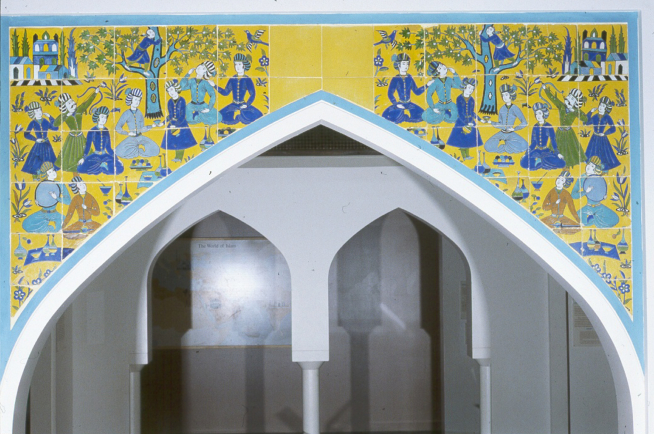Safavid Tile Project I: The Technology

Some of the most noticeable objects in the ROM's Wirth Gallery of The Middle East are two friezes of tiles that would have been in the spandrels of arches. These were made in Iran in the last third of the 17th century under the Safavid dynasty, probably for a palatial building in Isfahan. The ROM also has parts of other spandrel friezes, and also some stray tiles that belong to yet other friezes. In order to understand these objects more fully, ROM Curator-emeritus Lisa Golombek together with archaeologist and scientist Robert Mason (the present author) have been undertaking research on the tiles. For most of these tile friezes each tile would have an identical mirrored counterpart on the other side of the arch, and also another arch with an identical design elsewhere in the palatial building they were originally made for.

976.298.51 the fine black lines are the "dry" lines, which are applied over the white glaze with the coloured glazes, then a further "dry" line is applied for the beard and hair.
One of the things that interests me about these tiles is how they were made. They are decorated with a technique know as "cuerda seca" which means "dry chord" or "dry line" in Spanish, this technology having been very popular in Spain. Some "cuerda seca" ceramics are not actually made using the traditional technique, so it was important to investigate exactly how these tiles were made.
My usual approach to studying material like this is to cut it up and look at it with polarised-light microscopes and scanning electron microscopes, but in this case no part of the surface is appropriate for such destructive analysis. Instead I have been examining the tiles with the ROM's new high-powered digital microscope, while chemical analysis of the decoration is to be undertaken by Branden Rizzuto of the University of Toronto using a hand-held X-ray flourescence analyser.

976.298.51 detail of the eye of the bearded man.
The tiles start off as clay, as these are simple clay-based ceramics. The clay was probably shaped into a tile in a mould, and may have then been fired to earthenware temperatures (about 1000 degrees centigrade) in a "bisque" firing. The surface of the whole tile is then covered with a white opaque glaze, in the tile above you can see the white where it has not been covered by later applications of paint, such as the white parts of the cattle and the face of the man. The tile would then have been fired (being for the second time if there had been a "bisque" firing).

976.298.63 detail of broken section of a tile, with to left the "dry line" constraining pigments, specifically the transparent blue and opaque yellow, all over the opaque white glaze, in turn over the buff-yellow clay-ceramic earthenware body on the right.
The plain white tile would have then received the "dry line" which would be a paint incorporating wax and also a black pigment, which appears to include manganese judging by its purple hue. As each tile would have a mirrored counterpart on the other side of the arch and another arch with an identical design, the outline was probably initially created from a pattern or stencil. Patterns or stencils of thick paper which define a design with holes are well-known from this part of the world, and in this case would have created a line of dots on the white glaze. The painter would have then "joined the dots" to outline the design.

976.298.67 detail of dry line separating blue, yellow and green pigments.
Then the colours are applied. These are actually coloured glass, for instance the blue will be coloured with cobalt. In the application the pigmented glass is ground very fine and applied in a liquid medium. During application of these colours the "dry line" contains the fluid paint to the area it is wanted. During the firing the paint fuses to the surface of the glazed tile, and the wax is burnt off leaving the matt black line between the bright colours. There seems to be a limited "palette" of coloured pigment used on these tiles, the precise chemistry of which wll be determined by Branden's X-ray analyzer, but the microscopy reveals important details of opacity. As mentioned above, the base white glaze is opaque presumably by tin-oxide, so too is a bright yellow and a brown paint. The dark blue, pale blue, turquoise, purple/black, and green are transparent, with the only apparent inclusions being the colourant itself.
The artist then applies their finishing touches. Using the same black pigment as was used to outline the coloured glazes, details such as beard and hair which go *over* the coloured glazes are applied. The final tile would then have had a final firing.

976.298.51 detail of the moustache of the bearded man.
Lastly the edges of the tiles will have been ground down so that they fit each other and the curve of the arch, and installed!
LINKS:
Safavid Tile Project II: Rebuilding the Friezes
Wirth Gallery of the Middle East
